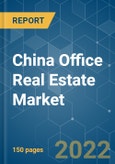Due to restrictions and social distancing policies, as well as a work-from-home culture, the COVID-19 epidemic had a significant impact on China's office real estate market. The COVID-19 pandemic in China has resulted in significant changes in workplace working habits and locations. As a result of the pandemic, the majority of businesses have implemented remote working.
The volume of commercial real estate investments in the Chinese mainland reached USD 7.3 billion in the third quarter of 2021, and the full-year amount is expected to surpass that of 2020. Office investments took the lion's share, or 57.6 percent, of the volume of commercial real estate investments in the third quarter, up 14.2 percent quarter-on-quarter. Eight office spaces in China, including Beijing Financial Street, Beijing's Central Business District, and Shanghai's Pudong New Area, were listed among the world's top 20 most expensive office spaces in 2021.
With the recovery of Beijing's commercial real estate investment market continuing through to year-end, the 2021 total sales volume exceeded 60 billion yuan with nearly 60 transactions recorded. The sales figure represented the second highest in the past five years, rising by a notable 35 percent from 2020. Office properties remained hot in 2021, accounting for 56 percent of the total transaction volume. In the first half of 2021, SK Tower sold for CNY 9.06 billion , making it the highest-priced single-asset deal to close since 2019. The total transaction volume for retail properties rose 34 percent year-on-year, with Brookfield's acquisition of Yuehui Vanke Plaza drawing great interest in the market.
Key Market Trends
Robust Leasing Demand For the Office Spaces Driving the Market
In Q2 2021, robust leasing demand pushed up nationwide net absorption to 2.09 million sq. m., slightly below the record quarterly high. Tier 1 cities account for over 50% of overall net absorption, other tech-driven Tier 2 cities such as Chengdu and Hangzhou, registered 100,000 sq. m. to 200,000 sq. m. of demand. The overall vacancy rate has been pushed down 0.6 ppts to 22.2% by robust demand, nationwide office rents fell by 0.2% q-o-q.
In the last year 2021, Beijing's office market set a new high as demand soared following the disruption caused by the COVID-19 outbreak, and this could raise expectations for 2022. The net absorption of the capital's Grade A office space reached about 1.02 million square meters in 2021,5.7 times higher than that of 2020. It marked the second time the data exceeded 1 million after 2010. The demand came mainly from information technology and finance companies, which contributed 41.7 percent and 21.9 percent, respectively, of the total transaction area.
Technology, media, and telecom companies such as Tencent, Byte-Dance, Alibaba, Huawei, Meituan, and Amazon contributed to several new bulk lease transactions last year 2021, of which the rental area is larger than 5,000 sq m. As a result of growing demand from top internet companies, four of the Grade A office markets in the city Financial Street, Zhongguancun, Wangjing and the area of Ya'ao-recorded a vacancy rate lower than 10 percent.
Demand for Co-Working Spaces Driving the Market
Over time, the number of co-working office spaces has increased dramatically. In addition, Beijing and Guangzhou are expected to be the leading cities in this industry, with a high number of co-working spaces. Meanwhile, Beijing remained a key commercial hub in the country, with most companies opting for co-working and shared office spaces. The second-largest coworking market in China is Wuhan, which has shared offices that attract a diverse spectrum of tenants, including major corporations, government agencies, and startups.
The majority of freelancers, entrepreneurs and small and medium-sized businesses (SMEs) are using co-working spaces. Because they offer excellent features and amenities like high-speed internet, 24-hour access to office space, meeting rooms, furnished and unfurnished offices, and so on. Furthermore, serviced offices (which comprise both creative and traditional offices) account for the majority of the co-working office space.
Despite the fact that China's SME sector is growing at a slow pace, the rising cost of business operations, which includes high commercial property rental costs, has prompted many aspiring small firms to seek for more cost-effective options. As a result, China is presently experiencing a major growth in Co-working culture, with Co-working spaces popping up all over the country.
Competitive Landscape
The China office real estate market is highly competitive, as the sector’s domestic and foreign participants produced a competitive environment. Some of the office real estate developers in the country include Wanda Group, Country Garden Holdings, China Vanke Co., Sunac China Holdings, Poly Real Estate. It has been observed that many new players are entering into the market as it is one of the most demanded markets these days.
Additional Benefits:
- The market estimate (ME) sheet in Excel format
- 3 months of analyst support
This product will be delivered within 2 business days.
Table of Contents
Companies Mentioned (Partial List)
A selection of companies mentioned in this report includes, but is not limited to:
- Wanda Group
- Country Garden Holdings
- China Vanke Co.
- Sunac China Holdings
- Poly Real Estate
- Evergrande Group
- China Overseas Land & Investment Ltd.
- Greenland Holding Group
- China Resources Land Ltd.
- China Merchants Shekou Industrial Zone Holdings
- Gemdale Corporation
- Henderson Land Development Company Limited*










